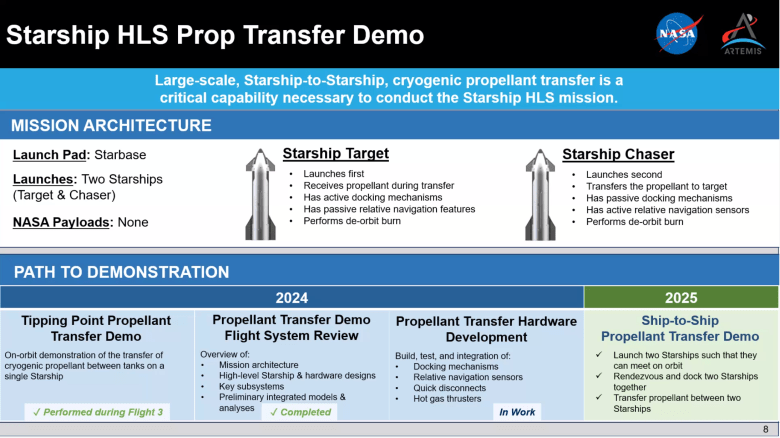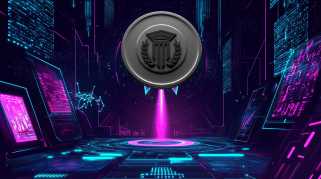
A test of transferring propellants between tanks on Starship during its March test flight was a success, NASA says. Credit: SpaceX
NASA는 3월 시험 비행 중 스타십의 탱크 사이에 추진제를 옮기는 테스트가 성공했다고 밝혔습니다. 크레딧: SpaceX
WASHINGTON — NASA says SpaceX is on track to demonstrate in-space refueling of Starship next year, a critical technology for returning humans to the lunar surface using that vehicle.
워싱턴 — NASA는 SpaceX가 내년에 우주선을 이용해 인간을 달 표면으로 돌려보내는 데 중요한 기술인 Starship의 우주 내 급유를 시연할 예정이라고 밝혔습니다.
Speaking to the NASA Advisory Council’s Human Exploration and Operations Committee April 26, Amit Kshatriya, NASA deputy associate administrator for the Moon to Mars Program, said SpaceX achieved one step towards refueling of Starship with a demonstration on the latest Starship test flight March 14.
4월 26일 NASA 자문 위원회의 인간 탐사 및 운영 위원회에서 NASA의 달-화성 프로그램 부국장인 Amit Kshatriya는 SpaceX가 3월 14일 최신 Starship 시험 비행 시연을 통해 Starship의 재급유를 향한 한 단계를 달성했다고 말했습니다.
During that flight, SpaceX performed an in-flight propellant transfer demonstration under a NASA Tipping Point contract awarded in 2020. SpaceX planned to transfer at least 10 metric tons of liquid oxygen from a header tank to the main tank within the Starship upper stage while in space.
해당 비행 중에 SpaceX는 2020년에 체결된 NASA Tipping Point 계약에 따라 기내 추진제 전송 시연을 수행했습니다. SpaceX는 비행 중에 헤더 탱크에서 스타쉽 상부 단계 내 메인 탱크로 최소 10미터톤의 액체 산소를 전송할 계획이었습니다. 공간.
While SpaceX said the day of the flight that it performed the demonstration, neither the company nor NASA provided any updates since then. At the advisory committee meeting, though, Kshatriya said the test appeared to go well.
SpaceX는 비행 당일 시연을 수행했다고 밝혔지만 회사나 NASA는 그 이후로 어떠한 업데이트도 제공하지 않았습니다. 그러나 자문위원회 회의에서 크샤트리아는 테스트가 잘 진행된 것 같다고 말했습니다.
“On Flight 3, they did an intertank transfer of cryogens, which was successful by all accounts,” he said, adding that analysis of the test is ongoing.
"3편에서 그들은 탱크 간 극저온유체 이송을 수행했는데, 이는 모든 면에서 성공적이었습니다."라고 그는 말하면서 테스트 분석이 진행 중이라고 덧붙였습니다.
The next major milestone is a demonstration planned for 2025 where two Starships will dock in orbit, with one transferring propellants to the other. Plans for that have passed a flight system review, according to a slide he presented at the meeting, examining the overall mission architecture and key subsystems, among other topics.
다음 주요 이정표는 2025년에 두 대의 우주선이 궤도에 도킹하여 하나가 추진체를 다른 우주선으로 옮기는 시연입니다. 그가 회의에서 발표한 슬라이드에 따르면 그에 대한 계획은 비행 시스템 검토를 통과했으며, 특히 전반적인 임무 아키텍처와 주요 하위 시스템을 검토했습니다.
In that mission, a “target” Starship will launch first and go into orbit, followed three to four weeks later by a “chaser” Starship. The two vehicles will dock with the chaser transferring propellants to the target. After the demonstration, the two Starships will undock and deorbit.
해당 임무에서는 "목표" 우주선이 먼저 발사되어 궤도에 진입하고 3~4주 후에 "추격자" 우주선이 뒤따릅니다. 두 대의 차량은 추진제를 목표물에 전달하는 체이서와 도킹됩니다. 시연이 끝난 후 두 우주선은 도킹을 해제하고 궤도를 이탈할 예정이다.
Kshatriya said SpaceX has some work ahead of that test, including understanding the slosh of propellants in the tanks as Starship maneuvers as well as the amount of “settling thrust” needed once the vehicles are docked to ensure propellant flows between them.
Kshatriya는 SpaceX가 우주선 기동으로 탱크 내 추진제의 출렁거림을 이해하고 차량이 도킹된 후 추진제 흐름을 보장하기 위해 필요한 "정착 추력"의 양을 이해하는 등 테스트에 앞서 몇 가지 작업을 수행하고 있다고 말했습니다.

A slide from Kshatriya’s presentation showing plans for the Starship propellant transfer demo.
우주선 추진체 이송 데모에 대한 계획을 보여주는 Kshatriya의 프레젠테이션 슬라이드입니다.
“The point of their flight test program before we do this is to make sure they fully understand the slosh dynamics, fully understand how the ullage is being maintained, what the settling thrust needs to be,” he said. “We’ve gone through it with them in terms of their plan for this. It’s a good plan.”
"이 작업을 수행하기 전에 비행 테스트 프로그램의 요점은 출렁거림 역학을 완전히 이해하고, 얼리지가 어떻게 유지되고 있는지, 안정 추력이 무엇인지 완전히 이해하는지 확인하는 것입니다."라고 그는 말했습니다. “우리는 이에 대한 그들의 계획에 관해 그들과 함께 겪었습니다. 좋은 계획이에요.”
Propellant transfer technology is essential to SpaceX’s plans for Starship missions beyond low Earth orbit, including the Human Landing System (HLS) version of Starship that will be used to land astronauts on the moon starting with the Artemis 3 mission, currently scheduled for no earlier than September 2026. Multiple Starship launches will transfer propellant into a depot in low Earth orbit that will then be used to fuel the HLS Starship, sending it to the moon.
추진체 전달 기술은 현재 예정된 Artemis 3 임무를 시작으로 우주비행사를 달에 착륙시키는 데 사용될 우주선의 인간 착륙 시스템(HLS) 버전을 포함하여 낮은 지구 궤도를 넘어선 우주선 임무에 대한 SpaceX의 계획에 필수적입니다. 2026년 9월. 다수의 우주선 발사는 추진제를 낮은 지구 궤도의 저장소로 옮긴 다음 HLS 우주선에 연료를 공급하여 달로 보내는 데 사용됩니다.
The exact number of refueling launches has been the subject of controversy, with estimates going as high as nearly 20. Kshatriya did not give a number of launches in his presentation, suggesting more work needs to be done to better understand the refueling process.
재급유 발사의 정확한 횟수는 논란의 대상이었으며 추정치는 거의 20회에 달했습니다. 크샤트리아는 프레젠테이션에서 몇 번의 발사를 언급하지 않았으며 재급유 과정을 더 잘 이해하려면 더 많은 작업이 필요함을 시사했습니다.
He said the company is working to understand factors like boiloff of propellants and leakage, as well as how much propellant can be effectively transferred from a Starship. “All of that is stuff that they know is in front of them, but all of that is stuff that’s in the plan to go characterize,” he said. “That will then derive the answer.”
그는 회사가 추진제의 증발 및 누출과 같은 요인뿐만 아니라 얼마나 많은 추진제가 스타쉽에서 효과적으로 전달될 수 있는지를 이해하기 위해 노력하고 있다고 말했습니다. "그 모든 것은 그들이 알고 있는 것들이지만, 그 모든 것은 특성화할 계획에 있는 것들입니다."라고 그는 말했습니다. “그럼 답이 나올 겁니다.”
The in-space propellant transfer test will be followed by an uncrewed demonstration mission of the HLS Starship, including fueling the vehicle and sending it to the moon for a landing. That mission will also feature an “ascent demo” not originally included in the plan, he said, to prove Starship can lift off the lunar surface.
우주 내 추진제 이동 테스트에 이어 차량에 연료를 공급하고 달 착륙을 위해 보내는 등 HLS 우주선의 무인 시범 임무가 이어질 예정이다. 그는 또한 그 임무에는 스타쉽이 달 표면을 이륙할 수 있다는 것을 증명하기 위해 원래 계획에 포함되지 않았던 "상승 데모"도 포함될 것이라고 말했습니다.
“Full & rapid reusability of booster & ship and orbital refilling of ship are the 2 fundamental technologies we aim to solve by the end of next year,” Elon Musk, chief executive of SpaceX, posted on social media April 26, responding to another post about Kshatriya’s presentation. “Those are the critical pieces necessary to make life multiplanetary.”
SpaceX의 CEO인 Elon Musk는 4월 26일 소셜 미디어에 다른 게시물에 응답하여 "부스터 및 선박의 완전하고 신속한 재사용 가능성과 선박의 궤도 재충전은 우리가 내년 말까지 해결하고자 하는 2가지 기본 기술입니다."라고 말했습니다. 크샤트리아의 발표에 대해. "이것들은 생명을 다행성으로 만드는 데 필요한 중요한 부분입니다."


 The Bit Journal
The Bit Journal BlockchainReporter
BlockchainReporter Optimisus
Optimisus DogeHome
DogeHome CFN
CFN Coincu
Coincu Cryptopolitan_News
Cryptopolitan_News Crypto Daily™
Crypto Daily™






















